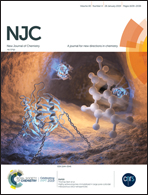Experimental and theoretical studies of solvent polarity influence on the preparation of molecularly imprinted polymers for the removal of estradiol from water
Abstract
The aim of this work was to study the synthesis of molecularly imprinted polymers (MIPs) for the selective adsorption of β-estradiol (E2). For this, six solvents with different polarities were tested and the results indicated that, for obtaining a good E2 adsorbent, the solvent should be moderately polar to favor the formation of a monomer–template complex during the synthesis. Synthesis with acetonitrile (ACN) or a mixture of chloroform (CFM) and dimethylsulfoxide (DMSO) 1 : 1 led to higher E2 adsorption capacities (from 26 to 37 mg g−1). The use of MIP-CFM:DMSO resulted in better results than that of MIP-ACN relative to their NIPs (about 3 times more for CFM:DMSO, compared to 1.5 times for ACN) for the adsorption capacities. This can be explained by the fact that ACN is a porogen solvent, which on one hand increased the area of the adsorbent material but on the other reduced its selectivity towards E2 adsorption.



 Please wait while we load your content...
Please wait while we load your content...